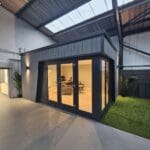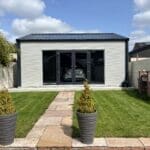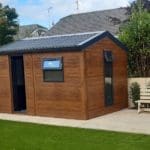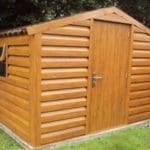Summer is the time of year when we get a lot of inquiries about buying a garden shed. People who have recently built or bought a new home are looking for a safe place to stow away the lawn mower. Or people with a shed that is bursting at the seams and are looking to upgrade.
Buying a garden shed is by no means complicated, but there are so many sheds on the market, which makes it hard to figure out which one is going to best suit your needs.
Firstly, garden sheds are used for so many different things from stowing garden equipment, DIY projects or hobbies, a space for an extra fridge/freezer, a changing room depending on what you do for work and hiding the household clutter. When you know what your shed is going to be used for it makes it a lot easier to figure out what exactly you need.
So here are our three tips for buying a shed.
1 Size
The size of the garden shed is dependent on two things – how much space you have in the garden and the use of the shed. Measure out the available space in the garden, decide what the max you can allocate to a shed and work from there. If the shed is going to be used for household clutter, then maybe go with a smaller shed. Household clutter tends not to take up more space than a small shed. IF the items are delicate or likely to be damaged by damp, then investing in an insulated shed would protect those items. If you are planning on storing a lawnmower, tools, bikes etc. you need to move up a size. And if you are thinking of using the shed as a hobby or DIY space, then choosing a large shed that will
comfortably accommodate you.
If you are not sure of how much shed space you are going to need, then go for a slightly larger shed. It’s better to be looking at space than looking for it.
2 Material
You have three options for your garden shed; wooden, plastic or steel. There are benefits and drawbacks to all materials.
- Wooden sheds have been the traditional choice for years. You see them dotted in gardens all over
Ireland. Wooden sheds tend to be airy, so you have less risk of condensation, making them ideal for storing items such as seeds. The downside of a wooden shed is that they have to be maintained, the wood will need to be treated with wood paint or preservative every year. - Plastic sheds are generally small, easy to assemble and easy to maintain. Generally speaking, they are not the most stylish shed out there, and they are small. So if you plan on storing household clutter, they might be ideal.
- Steel sheds are low maintenance, quick to install and can withstand the weather. There’s a wide range of steels sheds our there. We have a wide range of sheds in a variety of colours and wood effects with insulated walls and roof panels. The insulated sheds can retain heat when heated, so perfect for DIY and hobbies.
3 Planning
Before proceeding with the construction of your garden shed, it’s crucial to verify whether planning permission is required, which can vary based on its intended use. Seeking guidance from your local planning authority or organisations like Citizens Advice can provide up-to-date and accurate information tailored to your specific needs.
Factors such as the shed’s purpose and use influence the necessity of planning permission. While most garden sheds don’t typically require permission, it’s always prudent to confirm this with your local council.






